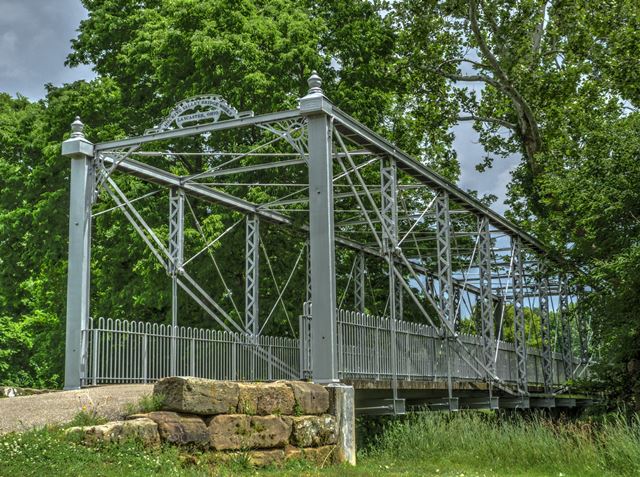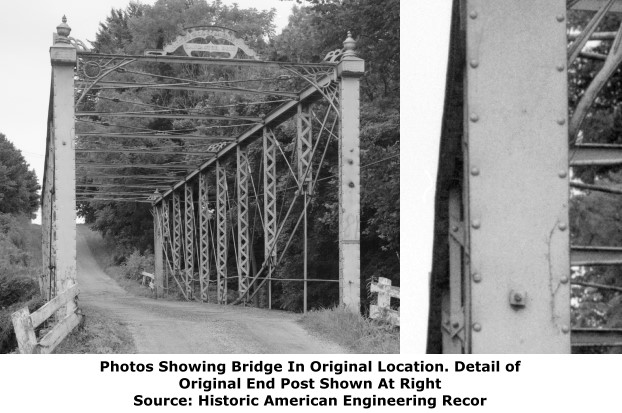We Recommend:
Bach Steel - Experts at historic truss bridge restoration.
BridgeHunter.com Phase 1 is released to the public! - Visit Now
John Bright Number 1 Iron Bridge
Havensport Road Bridge

Primary Photographer(s): Nathan Holth and Rick McOmber
Bridge Documented: June 8, 2014
Lancaster: Fairfield County, Ohio: United States
1884 By Builder/Contractor: Hocking Valley Bridge Works of Lancaster, Ohio
Not Available or Not Applicable
90.0 Feet (27.4 Meters)
90.0 Feet (27.4 Meters)
Not Available
1 Main Span(s)
23XXXX1

View Information About HSR Ratings
Bridge Documentation
View Historic American Engineering Record (HAER) Documentation For This Bridge
HAER Drawings, PDF - HAER Data Pages, PDF

Among the most unique surviving metal truss bridges in the United States is this inverted bowstring through truss. Because of the manner in which the chords of the truss are arranged, the deck is technically suspended from the truss system. The unusual truss design gives this bridge an appearance that is immediately recognizable as something unusual. The vertical end posts add to the unusual appearance.
Visually, the bridge is enhanced by its decorative cast iron finials, cast iron portal knee braces, and ornamental builder plaque.
An interesting structural detail on this bridge is how the end posts rest on cast iron shoes.
The bridge is the only known all-metal inverted bowstring through truss. There is a hybrid wood/iron covered bridge a short distance north of this bridge however. Visit Bridgehunter to learn more about that, since HistoricBridges.org does not "cover" covered bridges...
A lot of websites and documentations of this bridge list the name of this bridge by the somewhat awkward name of "John Bright Number 1 Iron Bridge." The bridge originally came from Havensport Road over Poplar Creek near Carroll, Ohio. The name "Havensport Road Bridge" is more representative of the bridge's origins. It was relocated here on the Ohio University-Lancaster campus in 1986 or 1999 depending on what website you look at. It has been rehabilitated for pedestrian use.
The end posts on this bridge have been removed and replaced with modern welded substitutes. It is a real mystery with this bridge: why were the end posts were not replaced in-kind with proper replicas, composed of riveted built-up beams. As vertical end posts, they are the first thing a visitor sees walking up to the bridge and are one of the most visible components on the bridge. And their plain, all-welded construction not only scream of modernity, they look profoundly out of place on the bridge. HistoricBridges.org recommends that future work on this bridge should replace the end post with riveted replicas. It would greatly improve the visual appearance of the bridge, to say nothing of the improvement in historical authenticity.
Information and Findings From Ohio's Historic Bridge InventorySetting/Context The bridge carries a pedestrian trail over a stream on the campus of Ohio University Lancaster. The bridge is located in a casually landscaped campus setting and provides access to recreational fields. Physical Description The wrought-iron bridge is a suspension truss design, sometimes referred to as an inverted bowstring, with the deck suspended from the truss. The 9-panel bridge has a built-up upper chord and verticals and eyebar lower chord and diagonals. The upper-lateral bracing is a T-shaped section. The end posts are composed of welded plates and channels and do not appear to be original, although the posts do appear to bear on original cast-iron shoes. The bridge is supported on concrete abutments. Integrity Relocated ca. 1986 and rehabilitated. Truss lines appear to be original with the exception of the welded end posts. Decking and flooring system is not original. Summary of Significance The John Bright No. 1 Iron Bridge is NR Listed (1978). It was relocated ca. 1986 from its original location on Havensport Road to the campus of Ohio University Lancaster where it now serves as a pedestrian trail. The bridge was rehabilitated and maintains excellent integrity to continue to convey its significance as a rare bridge type/design.From HAER OH-44" The John Bright No. 1 Iron Bridge was built by the Hocking Valley Bridge Works (HVBW) of Lancaster, Ohio, probably in 1884-5. It is one of a relatively small number of surviving bridges to have been built by this local firm. The suspension truss design is very unusual, and is only known to have been used in a few bridges in Ohio by three bridge builders. There are some similarities in this bridge to several patented designs, but it most closely resembles Archibald McGuffie's 1861 patent for "Improvement in Construction of Bridges." The bridge is very similar in design to the nearby John Bright Covered Bridge (see HAER No. OH-45, 14XXX16). The two bridges illustrate the transition from timber to all-metal construction. The John Bridge No. 1 Iron Bridge was listed on the National Register of Historic Places in 1978. Justification The bridge is a very rare type/design that has an exceptional level of significance. Bridge Considered Historic By Survey: Yes |
![]()
Photo Galleries and Videos: John Bright Number 1 Iron Bridge
Bridge Photo-Documentation
Original / Full Size PhotosA collection of overview and detail photos. This gallery offers photos in the highest available resolution and file size in a touch-friendly popup viewer.
Alternatively, Browse Without Using Viewer
![]()
Bridge Photo-Documentation
Mobile Optimized PhotosA collection of overview and detail photos. This gallery features data-friendly, fast-loading photos in a touch-friendly popup viewer.
Alternatively, Browse Without Using Viewer
![]()
Maps and Links: John Bright Number 1 Iron Bridge
Coordinates (Latitude, Longitude):
Search For Additional Bridge Listings:
Bridgehunter.com: View listed bridges within 0.5 miles (0.8 kilometers) of this bridge.
Bridgehunter.com: View listed bridges within 10 miles (16 kilometers) of this bridge.
Additional Maps:
Google Streetview (If Available)
GeoHack (Additional Links and Coordinates)
Apple Maps (Via DuckDuckGo Search)
Apple Maps (Apple devices only)
Android: Open Location In Your Map or GPS App
Flickr Gallery (Find Nearby Photos)
Wikimedia Commons (Find Nearby Photos)
Directions Via Sygic For Android
Directions Via Sygic For iOS and Android Dolphin Browser
USGS National Map (United States Only)
Historical USGS Topo Maps (United States Only)
Historic Aerials (United States Only)
CalTopo Maps (United States Only)


